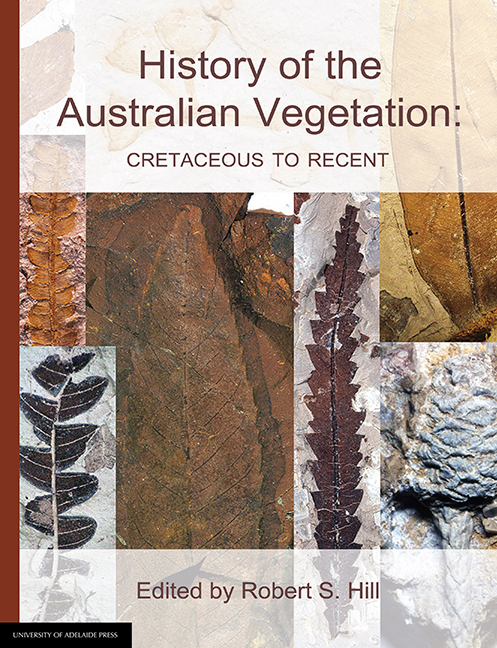Book contents
- Frontmatter
- Contents
- List of contributors
- Introduction to the 2017 edition
- 1 The Australian fossil plant record: an introduction
- 2 Maps of late Mesozoic-Cenozoic Gondwana break-up: some palaeogeographical implications
- 3 The background: 144 million years of Australian palaeoclimate and palaeogeography
- 4 Palaeobotanical evidence for Tertiary climates
- 5 Landscapes of Australia: their nature and evolution
- 6 Patterns in the history of Australia's mammals and inferences about palaeohabitats
- 7 Australian Tertiary phytogeography: evidence from palynology
- 8 Cretaceous vegetation: the microfossil record
- 9 Cretaceous vegetation: the macrofossil record
- 10 Early Tertiary vegetation: evidence from spores and pollen
- 11 The early Tertiary macrofloras of continental Australia
- 12 Cenozoic vegetation in Tasmania: macrofossil evidence
- 13 The Neogene: a period of transition
- 14 The Oligo-Miocene coal floras of southeastern Australia
- 15 Quaternary vegetation
- 16 The history of selected Australian taxa
- Taxonomic index
- General index
16 - The history of selected Australian taxa
Published online by Cambridge University Press: 25 July 2017
- Frontmatter
- Contents
- List of contributors
- Introduction to the 2017 edition
- 1 The Australian fossil plant record: an introduction
- 2 Maps of late Mesozoic-Cenozoic Gondwana break-up: some palaeogeographical implications
- 3 The background: 144 million years of Australian palaeoclimate and palaeogeography
- 4 Palaeobotanical evidence for Tertiary climates
- 5 Landscapes of Australia: their nature and evolution
- 6 Patterns in the history of Australia's mammals and inferences about palaeohabitats
- 7 Australian Tertiary phytogeography: evidence from palynology
- 8 Cretaceous vegetation: the microfossil record
- 9 Cretaceous vegetation: the macrofossil record
- 10 Early Tertiary vegetation: evidence from spores and pollen
- 11 The early Tertiary macrofloras of continental Australia
- 12 Cenozoic vegetation in Tasmania: macrofossil evidence
- 13 The Neogene: a period of transition
- 14 The Oligo-Miocene coal floras of southeastern Australia
- 15 Quaternary vegetation
- 16 The history of selected Australian taxa
- Taxonomic index
- General index
Summary
In examining the fossil record of the Australian flora since the arrival of angiosperms, several taxonomic groups loom large, either because they have an extensive and informative fossil record, or because they are prominent in the living vegetation and are selectively sought in the fossil record. The aim here is to consider some taxa that cover each of these areas in order to complement the vegetation reconstructions discussed in earlier chapters. There are several candidates that fall into the category of having an extensive fossil record, but the outstanding one is Nothofagus, which dominates many palynofloras, and is also well represented in the macrofossil record. The Podocarpaceae, Araucariaceae, Proteaceae and Casuarinaceae are also considered here because they have a mixture of good pollen and macrofossil records, and important evolutionary arguments can be based on these records. The prime example of a taxon that is prominent in the living vegetation and is actively sought in the fossil record is Eucalyptus, and its pollen and macrofossil record will also be considered, although it is much smaller than those of the other taxa. In choosing these taxa, several other notable groups have been excluded. In most cases this is because the record is biassed to either pollen (e.g. Acacia, Chenopodiaceae) or macrofossils (e.g. Lauraceae, cycads) and a combined data set cannot be supplied. There is no doubt that the greatest weakness lies with the macrofossil record, especially for those taxa that produce entire-margined, medium-sized leaves. Taxonomic research on these groups should be a priority for the future.
NOTHOFAGUS
Nothofagus has been described as the key genus in the study of southern hemisphere plant evolution and biogeography (van Steenis, 1971,1972). There are a number of reasons for this.
1. It has a completely southern hemispheric distribution, whereas its closest relatives are, and probably always have been, northern hemispheric.
2. It occurs in all the major Gondwanic land masses except Antarctica, where it has an extensive fossil record, and Africa and India, where it has never been recorded as an autochthonous fossil.
- Type
- Chapter
- Information
- History of the Australian VegetationCretaceous to Recent, pp. 390 - 420Publisher: The University of Adelaide PressPrint publication year: 2017



